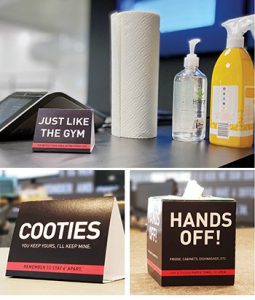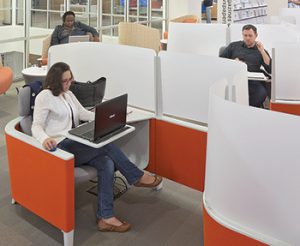
Libraries have always been spaces for discovery. But in light of the COVID-19 pandemic, they have been tasked with transforming themselves into places that allow users to physically distance while being more digitally connected than ever. As some institutions emerge from months of shutdowns, design and architecture experts seek to meet current health and safety challenges as well as safeguard these community spaces against an uncertain future.
Traci Engel Lesneski, CEO and principal at Minneapolis-based national architecture firm MSR Design, which has worked with hundreds of libraries across the country, says libraries are ideal spaces for innovative design solutions. “It’s not a stretch to think about the ways that libraries have modeled what’s next in the world,” she says. “Libraries can talk to the public about how important these things are and advocate [for them]. They can provide hands-on learning and access to certain technologies that people don’t have access to in their everyday lives.”
Yet libraries have had to find new ways to provide that access. “[COVID-19] is aggravating the digital divide,” says Susan Nemitz, director of Santa Cruz (Calif.) Public Libraries (SCPL). “There are a number of people who don’t have access to the internet and computers, because we haven’t opened up yet.” She says that effective design solutions will have to bridge not just physical and digital distance, but socioeconomic distance as well.
“We find that, more and more, our community is isolated,” she says. “And we’ve been moving away from being a warehouse of books to being a social connector.” Nemitz, whose library system passed a $67 million bond issue to replace and remodel all 10 of its buildings before the pandemic hit, says she’s had to reimagine her library’s mission. “The COVID crisis has thrown a wrench into who we are and what we believe,” she says. “Do we build our buildings for the situation we’re in now, or the situation in the long run?”
The answer may be both. “This will not last forever,” says Amanda Markovic, architect and associate principal at GBBN Architects, a multinational architecture and interior design firm that has built multiple libraries and civic spaces around the country. “But there’s a possibility that it will happen again. So I think [design] is about ensuring there’s flexibility, making sure there aren’t as many hard walls in these spaces to allow for the expansion and contraction [of our spaces] that will be necessary when these things arise.”
An early start
Libraries that were in the process of renovating before COVID- 19 almost immediately pivoted, repurposing certain design features to address the new normal. “There have been some fortunate coincidences that were not intended to be in reaction to a pandemic but that we can use,” says Markovic. “For instance, at Baldwin Borough Public Library [in Pittsburgh], we put casters on the stacks to make them easy to move around. We can now use them to create little pods. And at Carnegie Library [of Pittsburgh], we’re implementing cleanable surfaces and discussing an HVAC system that allows for increased ventilation.”

Some privacy features have been reimagined as safety enhancements. “We’ve been in a debate about gendered versus nongendered toilet rooms,” says Lesneski. “When you put the lens of the pandemic over that, we should be moving toward more privacy, and privacy that allows for parent and child, or parent and older parent, or people who need to use medication, or transgender people. So we’ve been talking more about [creating bathrooms that consist of] roomlets with a sink, where everything is all contained.”
Libraries that have been unable to provide public access during the pandemic may have an unusual opportunity to upgrade. “One of our libraries that was renovated had its entire collection digitized when it was removed for the renovation,” says Thomas M. Hotaling, architect and principal at Ann Beha Architects, a Boston-based design firm that works with education and cultural clients. “I’m wondering if this might be a good time for [other] libraries to digitize their collections. If the funding is available, this is an ideal time to think about that.”
Clean and simple
Certainly funding is an issue. But not all changes need to be expensive. In fact, some of the most effective enhancements libraries can employ involve only elbow grease and motivation. “One of the things that works is just cleaning,” says Markovic. “A good old ‘let’s wipe things down.’ And do that often.” She says that high-touch areas like doors and desks should ideally be nonporous and cleaned often. “I think of gyms,” she says. “You have to wipe down equipment after using it, and that becomes easy, because they put the wipes near the equipment. So putting wipes near furniture and the front desk and near where people might want to go would be a visual cue.”
Lesneski says that library guests should also be a part of that process. “We will have to take personal responsibility to clean up after ourselves and have trust in other people,” she says. “And we might have to start carrying around sanitizer.” She explains that rooms can be designed or redesigned to incorporate built-in receptacles for sanitizing wipes and feature signage that directs visitors to use them.
This will not last forever. But there’s a possibility that it will happen again.—Amanda Markovic, architect and associate principal at GBBN Architects
Technology solutions can also make spaces cleaner and safer. Touchless lights, faucets, and doors may become more common, and libraries may begin to experiment with automated cleaning protocols. “Maybe there’s an automatic occupancy sensor that turns on a UV light that [could kill] the most recent virus, like task lights at every computer,” says Cindy Kaufman, principal associate at Holt Architects, a New York design firm with offices in Syracuse and Ithaca that has worked on several university libraries and learning spaces. “Or what if it was a little machine that sits right next to you and does a quick cleaning?”
Kaufman cautions against the use of antimicrobials, as those treatments can be largely ineffective and potentially unhealthy. “I think some people are using antimicrobial treatments, but we [at Holt] don’t recommend them because we have a huge focus on sustainable design and healthy design,” she says. Antimicrobials can prevent the growth of microorganisms but won’t always kill them, she says. “If a facility is on top of cleaning, they can kill the virus that way.”
Products and placement
Design can do more than just help keep things clean. It can also provide visual reminders of social distancing, as seen in the large circles painted on lawns in New York City’s Domino Park and Chicago’s Millennium Park. Indoors, that can translate into strategic furniture placement. “Especially in facilities that don’t have money [to remodel], I see the possibility that furniture is arranged in a completely different way, so you spread out how people can sit,” says Kaufman. “You could spread out a row or a long table and remove every few chairs. If people need to face each other, you could put up a barrier or a sneeze guard or a panel. Mobile screens can be another way to create separate seating.”
Product design is quickly evolving to meet the needs of environments that practice social distancing. “You’re seeing products pop up”—such as planters, fabric screens, and marker boards that act as dividers—“[that] feel natural but also keep people at a distance,” Lesneski says. Furniture still needs to be welcoming, she adds, because otherwise people won’t want to be there. “We can’t look like we’re living in a surgical ward,” she says. “And we don’t want to end up in terrible places with windows that are sealed shut and seating that’s not comfortable, and furniture that’s been bolted into place to prevent people from moving too close.”

She says comfort is also about control. “The more control we have over our environment, the more content we feel,” says Lesneski. “Like controlling the lights, airflow, height of a table, or size of its surface. The more control, the more secure and able to focus we are.”
Libraries can also get their communities involved in the design process. Margaret Sullivan, principal at Margaret Sullivan Studio, a New York City–based design firm that specializes in libraries and learning institutions, says that working with local graphics shops and inviting artists and graphic designers to create temporary signage can help libraries find vibrant and playful ways to speak to their patrons. “This is a great time to pay young designers in your community,” she says. “A great impact investment strategy would [also] be to hire local architects and designers to come up with cool design solutions for social, learning, and community spaces that foster social distancing in a fun, creative way.”
Storage solutions will also need to be developed as spaces become more malleable. “Social distancing will impact the amount of furniture that’s in a space, at least for the present,” says Hotaling, who suggests libraries might even see a return to old-fashioned reading carrels. “We were asked [by a library client] what to do with all the furniture now there. Where will it be stored, and should library designers be thinking about library furniture that can be easily stacked?” Hotaling says storage considerations will also affect collections, as many libraries now have a process for quarantining materials. “Libraries have to dedicate space for books to sit for three days and then be cleaned too,” he says.
Outside the box
As scientists learn more about the transmission of COVID-19, the importance of using outdoor space as much as possible has repeatedly been stressed. “Outside is safer than inside,” says Sullivan. “So are the services going to be curbside pickup? Will there be outdoor programming?” She adds that librarians will need to think about how many people can be inside a facility and what those people will be doing. “Then you can start to get granular,” she explains. “For the first phase of opening, maybe we have this many tables we need to clean every night and this many computers that need to be sanitized. That’s an interesting way to think about the true cost of the work.”
Designers are also thinking about how to better ventilate indoor spaces. “Everyone is looking at improved indoor air quality for HVAC systems, more operable windows, more fresh air, and more air circulation,” says Hotaling. “Fresh air is proven to make for a healthier environment.”
Fostering the impression of a natural environment can also soften spaces and encourage spatial division. “I could see using a mobile system of translucent panels featuring images of greenery and nature,” says Kaufman. “Or what if there were curtains that were able to move around the ceiling on a track to create private areas, and that let light through, and that are cleanable, and that could be drawn from one position to another?”
Outside is safer than inside. So are the services going to be curbside pickup? Will there be outdoor programming?—Margaret Sullivan, principal at Margaret Sullivan Studio
As libraries bring the outdoors inside, they’re also bringing traditional indoor services outside. “There’s a trend in creating outside spaces and leaving our Wi-Fi on,” says Nemitz of SCPL. “Maybe even expanding coverage so we can be a Wi-Fi hotspot, so students can use it at 4 a.m. if they don’t have Wi-Fi at home, whether we’re open or not.” Nemitz is also considering a wireless printing service, so library guests can print from their connected devices for curbside pickup.
“We have a lot of people who love print books and who are suddenly motivated to download books,” says Nemitz. “This kind of thing is going to forever change us. There’s an audience that can’t physically come to our building, and this allows people who previously felt barriers to participate.”
Not all outdoor improvements are tech-driven. “Sometimes the old becomes new again,” says Nemitz, pointing to old book drops located near several branches in her system. “The public loves [them]. The staff collects and quarantines the books. And some of our libraries have a drop-off island, and with curbside pickup it’s ideal.”
Even entrances can become design features. “Our design allows the library to be open and closed in sections,” says Nemitz, who adds that SCPL adopted the concept from a library in Madison, Wisconsin. “We can open just the children’s area or just the adult area, and we can serve different clienteles at different times.”
Looking ahead
Designers say that the COVID-19 pandemic is an opportunity not just to modify libraries but to improve them for future use.
“This is about so much more than having less seating and different planning,” says Kaufman. “It’s about human-environmental interactions, and how can we affect human behavior with simple design tools. In my mind, it’s imagery and spatial reconfiguration that can help people feel more [connected] to each other. Buildings will need to create more usable spaces for people to spread out more, and users need to trust the staff.”
Lesneski says that a lot of existing built environments have barriers that hinder inclusivity at multiple levels, including racially and socioeconomically. She cites a discussion moderated by the Canadian Urban Institute. Ironically, a shift to more equitable spaces will happen because the virus has made decision makers “uncomfortable,” she says. “We [should] remember to expand our lens so that it’s not just about the pandemic but also a long-term overhaul.”


